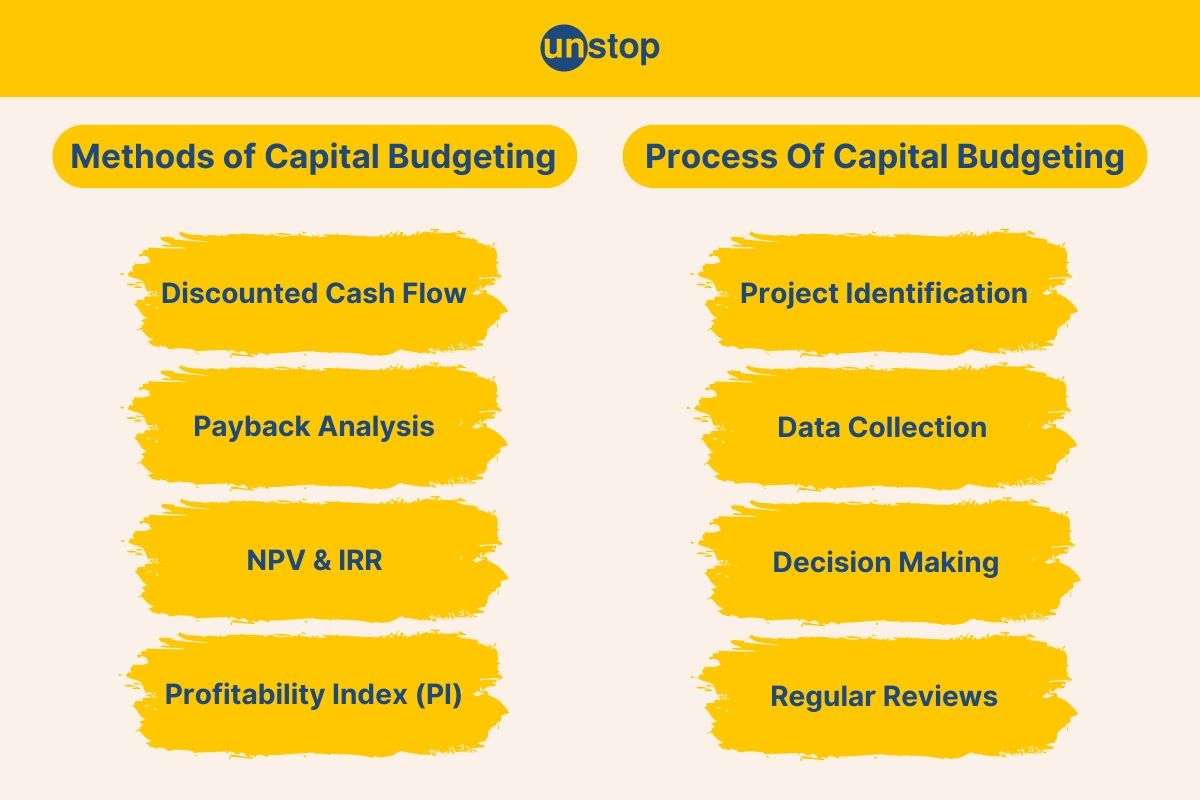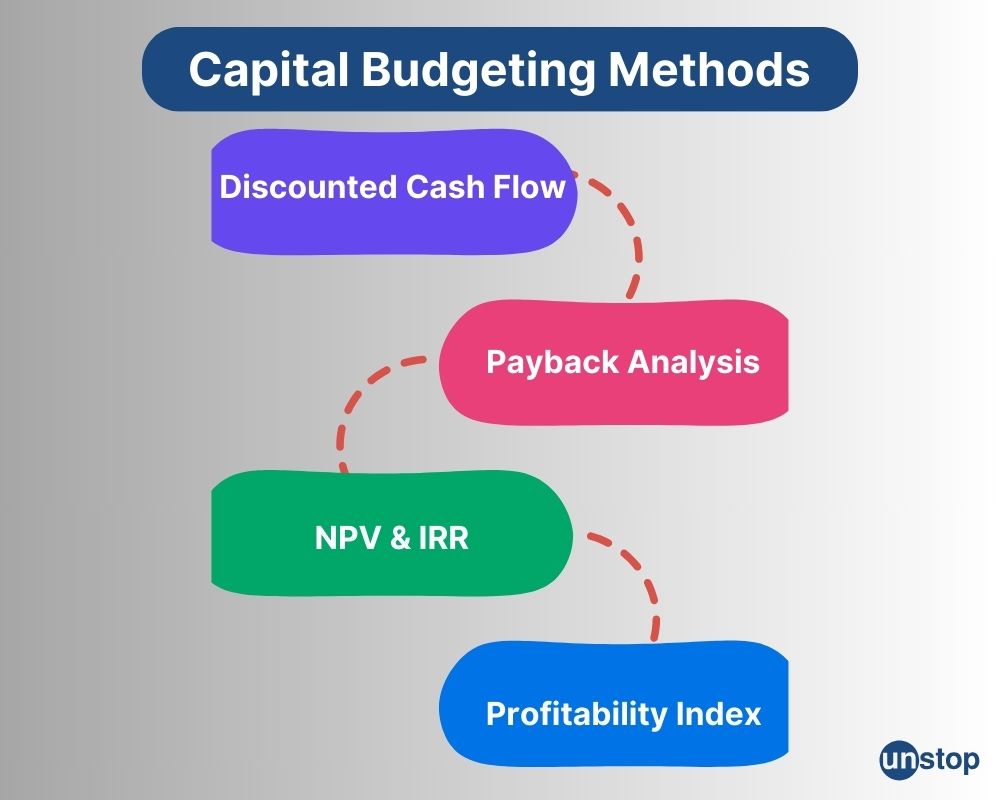- What Is Walter's Model Of Dividend?
- Key Concepts Of Walter's Model
- Dividend Policies
- Walter's Model Formula And Assumptions
- Model Limitations
- Conclusion
- Frequently Asked Questions
- Exploring Cash And Fund Flow
- Importance Of Cash & Fund Flow Statement
- Components Of Cash & Fund Flow Statement
- Exploring The Key Differences With Examples
- Significance And Application
- Advantages And Disadvantages
- Conclusion
- Frequently Asked Questions
- Definition Of Comparative Statement
- Types Of Comparative Statements
- Formulas For Comparative Statement
- Example Of Comparative Income Statement
- Preparing Comparative Statement
- Steps For Income & Balance Sheets
- Understanding Cash Flow Comparisons
- Practical Examples Explained
- Limitations And Considerations
- Conclusion
- Frequently Asked Questions (FAQs)
- Definition Of Dividend Decision
- Key Factors Influencing Dividend Decision
- Objectives Of Dividend Decision
- Theories And Determinants
- Policies Of Dividend Decision
- Conclusion
- Frequently Asked Questions (FAQs)
- Role of Fund Flow Statement Analysis
- Key Objectives of Preparing a Fund Flow Statement
- Importance of a Fund Flow Statement
- How to Prepare a Fund Flow Statement: A Step-by-Step Guide
- Fund Flow Statement vs. Cash Flow Statement
- How Fund Flow Analysis Empowers Investors and Management
- Limitations of a Fund Flow Statement
- Conclusion
- Frequently Asked Questions (FAQs)
- Definition Of Financing Decision
- Types Of Financial Decisions
- Examples Of Financing Decisions
- Key Factors In Financial Decision-Making
- Theories Of Financial Decision
- Analyzing Costs And Risks
- Evaluating Market & Regulatory Impacts
- Conclusion
- Frequently Asked Questions (FAQs)
- Definition Of Finance Function
- Core Components Of Finance Function
- Functions Of Financial Management
- Importance Of Finance Decision
- Scope Of Finance Function
- Objectives Of Financial Management
- Integrating Decisions Into Business Strategy
- Conclusion
- Frequently Asked Questions (FAQs)
- Definition Of Profit & Wealth Maximization
- Top 5 Key Differences Highlighted
- Calculation Method (Formula)
- Which Approach Is More Sustainable
- How It Impacts Different Stakeholders
- Role Of Decision-Making In Maximization
- Conclusion
- Frequently Asked Questions (FAQs)
- Definition Of Capital Structure
- Top 10 Factors Affecting Capital Structure
- Conclusion
- Frequently Asked Questions (FAQs)
- Defining Working Capital Cycle
- Importance Of Working Capital Cycle
- Components Of Working Capital Cycle
- Steps Of Working Capital Cycle
- Formula Used For Calculation
- Positive vs Negative Working Capital
- Reducing The Cycle
- Conclusion
- Frequently Asked Questions
- What is a Common Size Statement?
- Common Size Statement Format & Formula
- Common Size Statement Analysis
- Importance of Common Size Statement
- Difference Between Common Size and Comparative Statement
- Conclusion
- Frequently Asked Questions (FAQs)
- Definition Of Gordon Growth Model
- Formula & Example Of GGM
- Applications In Investment Valuation
- Gordon Growth Vs. Dividend Discount Model (DDM)
- Pros And Cons Of The Model
- Conclusion
- Frequently Asked Questions (FAQs)
- Definition & Concept Of Maximization
- Importance & Benefits Of Wealth Maximization
- Approaches & Challenges
- Wealth Maximization Vs. Profit Maximization
- Strategies To Implement Wealth Maximization
- Relation Of Psychological Aspects & Wealth
- Conclusion
- Frequently Asked Questions (FAQs)
- What Is Investment Decision? (Meaning)
- Key Factors Influencing Investment Decisions
- Importance of Investment Decision
- Exploring Capital Budgeting Methods
- Net Present Value Vs Internal Rate Of Return
- Addressing Inflation Effects
- Conclusion
- Frequently Asked Questions (FAQs)
- What Is Discounted Payback Period?
- Understanding The Basic Concept
- Formula & Calculation With Example
- Advantages, Disadvantages And Application
- Payback Vs. Discounted Payback
- Role & Influence Of Decision Rule Explained
- Conclusion
- Frequently Asked Questions (FAQs)
- What Is Working Capital Management
- Key Components Of Working Capital
- Importance Of Working Capital Management
- Working Capital Cycle & Formula
- Key Ratios In Working Capital Management
- Factors Influencing Working Capital
- Strategies For Working Capital Management
- Conclusion
- Frequently Asked Questions (FAQs)
- Meaning Of Financial Sources In Business
- Primary And Secondary Sources Of Finance
- Top 7 Sources Of Finance For Business
- Traditional Vs Modern Sources Of Finance
- Classification Of Finance Sources Based On Time Period
- Classification & Impact Based On Ownership
- Strategies For Choosing The Right Sources Of Finance
- Conclusion
- Frequently Asked Questions (FAQs)
- What Is Profitability Index?
- Key Features Of PI As A Financial Tool
- Profitability Index Formula
- How To Calculate Profitability Index
- Advantages & Disadvantages Of PI
- Conclusion
- Frequently Asked Questions (FAQs)
- What Is Annual Recurring Revenue?
- Importance Of ARR For Business Growth
- Formula And Steps To Calculate ARR
- Differences Between ARR and MRR
- Conclusion
- Frequently Asked Questions
- What Is Capital Budgeting?
- Types & Features Of Capital Budgeting
- Importance Of Capital Budgeting
- Methods Used In Capital Budgeting
- Capital Budgeting Process
- Capital Budgeting Vs. Operational Budgeting
- Conclusion
- Frequently Asked Questions (FAQs)
- What Is Financial Statement Analysis?
- Importance & Benefits
- Types Of Financial Statement Analysis
- Methods Of Financial Statement Analysis
- Steps In Financial Statement Analysis
- Conclusion
- Frequently Asked Questions (FAQs)
- What Is The Cost Of Capital?
- Key Components Of Cost Of Capital
- WACC & Formula
- Factors Influencing Cost Of Capital
- Role Of Cost Of Capital In Financial Decisions
- Role In Investment Decisions & Mergers
- Impact On Business Operations & Strategies
- Conclusion
- Frequently Asked Questions
- What Is Internal Rate Of Return (IRR) In Finance?
- Key Concepts Of IRR
- Formula To Calculate Internal Rate Of Return
- Applications Of IRR In Finance
- Limitations & Challenges Of IRR
- Conclusion
- Frequently Asked Questions (FAQs)
- What Is Cost of Equity?
- Key Factors Affecting Cost Of Capital
- Role Of Cost Of Equity In Finance
- Methods to Calculate Cost of Equity
- Formula Of Cost Of Equity
- Components Of Cost Of Equity
- Cost Of Equity Vs. Related Financial Concepts
- Conclusion
- Frequently Asked Questions (FAQs)
- What Is Ratio Analysis?
- Importance Of Ratio Analysis
- Types Of Financial Ratios Analysis
- Methods Used To Conduct Ratio Analysis
- Applications And Examples
- Conclusion
- Frequently Asked Questions (FAQs)
- What Is Net Present Value (NPV)?
- Why Use NPV? Top 5 Benefits
- NPV Formula Explained
- Steps To Calculate NPV With Example
- Positive Vs. Negative NPV
- Advantages And Disadvantages Of NPV
- NPV Vs. Other Financial Metrics
- Conclusion
- Frequently Asked Questions
- What Is The Time Value Of Money?
- Time Value Of Money Formula
- Importance Of Time Value Of Money
- Methods & Techniques Of Time Value of Money
- Relationship Between Opportunity Cost And Time Value
- Inflation's Impact on Time Value
- Conclusion
- Frequently Asked Questions (FAQs)
- What Is Financial Management?
- Types of Financial Management
- Importance of Financial Management
- Key Functions Of Financial Management
- Best Practices For Financial Management
- Conclusion
- Frequently Asked Questions
- What Is Leverage In Financial Management?
- Types Of Leverage In Financial Management
- Financial Leverage Formula
- Risks & Benefits Of Financial Leverage
- Conclusion
- Frequently Asked Questions
- What Is A Dividend?
- Types Of Dividends
- Dividend In Financial Management
- Examples Of Dividend
- Impacts Of Dividends On Share Prices
- Reasons Companies Pay or Not Pay Dividends
- Conclusion
- Frequently Asked Questions
Capital Budgeting: Definition, Types, Importance, Methods & Process

Capital budgeting helps businesses decide how to allocate their resources effectively. Companies analyze potential investments and projects to maximize returns. This method ensures that funds are directed toward profitable ventures.
In this article, we will delve into the meaning, importance, methods, and benefits of capital budgeting in today's fast-paced economy. Prepare to enhance your financial decision-making skills.
What Is Capital Budgeting?
Capital budgeting refers to the systematic planning process used by firms to assess the worthiness and profitability of purchasing new machinery, expanding facilities, launching new products, or undertaking significant research and development projects which comprises the long-term investments of the companies.
The primary goal is to determine whether these investments will generate sufficient returns to justify the initial expenditure.
It involves a detailed analysis of the potential returns, costs, and risks associated with proposed investments, ensuring that the company allocates its resources effectively to maximize long-term profitability and growth.
Types & Features Of Capital Budgeting
Let us take a look at some of the types and features of capital budgeting:
Types
Types of capital budgeting projects include:
Expansion Projects: Investments to increase the company's operational capacity or enter new markets.
Replacement Projects: Investments to replace old or inefficient assets with new, more efficient ones.
New Product Development: Funding for the research, development, and launch of new products.
Cost Reduction Projects: Investments aimed at lowering operational costs and improving efficiency.
Regulatory Compliance Projects: Investments required to meet government regulations and standards.
Research and Development (R&D): Investments in innovation to develop new technologies or processes.
Safety and Environmental Projects: Investments aimed at improving workplace safety and reducing environmental impact.
Features
Key features of capital budgeting include:
-
Large-scale Investments: Involves significant financial outlays.
-
Long-term Impact: Affects the company's operations and profitability over an extended period.
-
Risk and Uncertainty: Requires careful assessment due to the inherent risks and uncertainties.
-
Irreversibility: Investment decisions are often difficult to reverse once made.
-
Future Cash Flows: Focuses on estimating and evaluating future cash flows generated by the investment.
Importance Of Capital Budgeting
Capital budgeting is important for several key reasons:
Optimal Resource Allocation: Ensures that a company's limited financial resources are invested in projects that offer the highest potential returns, leading to efficient use of capital.
Long-term Strategic Planning: Helps in planning and executing long-term growth strategies by identifying and funding projects that align with the company's goals.
Risk Management: Reduces financial risk by thoroughly analyzing the potential costs, benefits, and uncertainties associated with investment projects.
Financial Stability: Contributes to long-term financial health by focusing on investments that generate sustainable and profitable returns.
Competitive Advantage: Supports investments in innovation, technology, and new market opportunities, helping the company stay competitive and ahead of industry trends.
Regulatory Compliance: Ensures that necessary investments are made to meet the legal and regulatory requirements, avoiding potential fines and legal issues.
Stakeholder Confidence: Demonstrates to investors, creditors, and other stakeholders that the company is making informed and strategic investment decisions, which can enhance their confidence and support.
Methods Used In Capital Budgeting

The most commonly used methods in capital budgeting include:
Discounted Cash Flow
Discounted cash flow analysis is a key method in capital budgeting. This technique estimates the value of an investment based on its expected future cash flows. These cash flows are adjusted for the time value of money.
This means that cash received today is worth more than cash received in the future. By using this method, companies can evaluate projects more accurately. It helps determine if an investment will generate sufficient returns over time.
Payback Analysis
Payback analysis is one of the simplest capital budgeting methods. It calculates how long it takes to recover the initial investment. This method focuses on liquidity. Businesses often prefer it because it offers quick insights into project feasibility.
However, payback analysis has limitations as it does not take into account the cash flows beyond the payback period. Other methods like net present value and internal rate of return provide a more comprehensive view.
NPV & IRR
Net Present Value (NPV) measures how much more the cash inflows are worth compared to the cash outflows throughout the duration of a project.
On the other hand, the Internal Rate of Return (IRR) identifies the discount rate that makes the NPV of an investment zero, representing the project's expected rate of return.
Profitability Index (PI)
The Profitability Index (PI) is an important tool in capital budgeting that evaluates how appealing an investment is. It does this by taking the present value of expected future cash flows and dividing it by the initial cost of the investment.
If the PI is above 1, it indicates that the project is likely to generate profit, helping companies focus on investments that yield the best returns compared to their costs.
Capital Budgeting Process
Let us look at some of the important aspects and factors involved in the capital budgeting process:
Project Identification
Identifying potential projects is the first step in the capital budgeting process. Companies look for opportunities that align with their strategic goals. This might involve new investments or upgrades to existing assets.
Data Collection
Data collection is critical in this phase. Accurate information on costs, revenues, and risks is essential. Companies need to gather historical data and market trends to support their analysis.
Decision Making
Capital budgeting decisions require careful consideration. Stakeholders review the results of the analysis to determine which projects to pursue. A competent capital budgeting process ensures that resources are allocated efficiently.
Regular Reviews
Regular reviews of the capital budgeting plan are necessary. Businesses must adapt to changing environments and market conditions. Adjustments may be needed based on performance and new information.
Capital Budgeting Vs. Operational Budgeting
Lastly, it is important for us to know the differences and similarities between capital budgeting and operational budgeting.
Long-term Focus
Capital budgeting centres on long-term investments. It involves planning for projects that will take years to yield returns. Businesses use this approach for significant expenditures, like new equipment or facilities.
Operational budgeting, however, focuses on daily expenses. It addresses the costs needed to keep current operations running smoothly. This includes salaries, utilities, and supplies.
Expansion & Maintenance
Decisions made in capital budgeting can lead to expansion opportunities. For instance, a company may invest in new technology to grow its market share. Such decisions shape the future of the business.
Operational budgeting maintains existing operations. It ensures that funds are allocated properly for ongoing needs. Companies prioritize stability over growth when managing these budgets.
Time Frames
The time frames for these two types of budgeting differ significantly. Capital budgeting looks ahead, often spanning several years into the future. This long-term view allows businesses to plan effectively.
In contrast, operational budgeting operates on a short-term basis. Typically, it covers one year or less. This focus helps companies manage immediate financial needs while keeping current operations efficient.
Conclusion
Capital budgeting helps you make informed decisions about long-term investments and ensures that your resources are allocated effectively. Understanding the various methods and processes involved empowers you to choose the right projects, maximizing returns while minimizing risks.
Capital budgeting is essential for companies, allowing them to effectively manage their resources, assess risks, and secure long-term financial health. By thoroughly analyzing and choosing the right investment opportunities, businesses can foster sustainable growth, maintain a competitive edge, comply with regulations, and ultimately enhance their overall success.
You're not done yet! How about playing this quiz to see how much you've retained?
Frequently Asked Questions (FAQs)
1. What is capital budgeting?
Capital budgeting refers to the systematic planning process used by firms to assess the worthiness and profitability of purchasing new machinery, expanding facilities, launching new products, or undertaking significant research and development projects which comprises the long-term investments of the companies.
2. Why is capital budgeting important?
Effective financial planning relies heavily on capital budgeting. This process helps in the smart allocation of resources, which boosts profitability while reducing the risks tied to investments.
3. What methods are used in capital budgeting?
Common methods include Net Present Value (NPV), Internal Rate of Return (IRR), Payback Period, and Profitability Index. Each method helps assess potential investment returns.
4. What are the steps in the capital budgeting process?
The capital budgeting process includes identifying investment opportunities, analyzing potential returns, selecting projects, and monitoring performance post-investment to ensure goals are met.
5. Who should be involved in the capital budgeting process?
Key stakeholders such as finance teams, project managers, and executives should be involved. Their insights ensure comprehensive evaluation and alignment with business objectives.
Suggested Reads:
- Annual Recurring Revenue (ARR): Definition, Formula & Calculation
- Top 7 Sources Of Finance For Businesses And Start-ups Explained
- Working Capital Management: Definition, Importance, Strategy & More
- Gordon Growth Model (GGM) | Definition, Formula, And Applications
- Common Size Statement: Definition, Types, Formula & Preparation
Instinctively, I fall for nature, music, humor, reading, writing, listening, traveling, observing, learning, unlearning, friendship, exercise, etc., all these from the cradle to the grave- that's ME! It's my irrefutable belief in the uniqueness of all. I'll vehemently defend your right to be your best while I expect the same from you!
Login to continue reading
And access exclusive content, personalized recommendations, and career-boosting opportunities.
Subscribe
to our newsletter
















Comments
Add comment